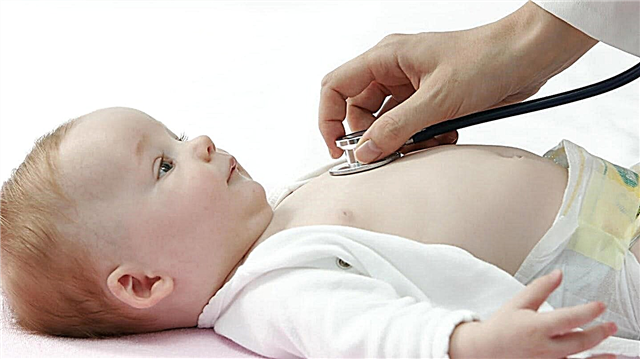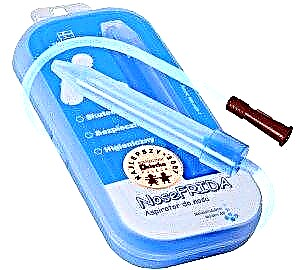Often babies suffer from constipation. More often it occurs in children who eat formula, especially if babies are not given water. In rare cases, it is recommended to provoke a bowel movement with a cleansing enema. You can put it at home for a small child only on the advice of a doctor. It is important to know about the contraindications and consequences of the procedure, which can lead to a violation of the execution technique.

Baby
What is an enema
An enema for a child, especially a baby under one year old, is recommended to be done only in extreme cases. It is impossible to independently resort to such a method in order to speed up the defecation of the crumbs. This should be done only after a doctor's appointment, following all the recommendations. A procedure done with mistakes often leads to health problems for the child.
Varieties of enemas
Various goals can be achieved with an enema:
- Relieve constipation by using warm liquid. A cleansing enema is allowed to be carried out at home;
- Replenish the lack of substances needed by the baby. For example, this may be required during illness. Siphon enema is used for severe intoxication, intestinal obstruction. It is rarely used, usually when a cleansing enema does not work;
- Deliver nutrients to the body when there is no way to get food in another way;
- Provide the child with medicine. Some drugs are absorbed faster and more efficiently in the intestines. Also, the procedure is necessary to relieve inflammation of the organ. Such manipulations, as well as providing food, are carried out for infants exclusively in hospitals. Before medicinal enemas, cleansing is always done, otherwise the meaning of the procedure is lost;
- Diagnose bowel diseases. The medical staff injects a special solution with contrasting properties. After that, you need to do an x-ray. The picture shows the structure of the intestine, whether it is twisted, whether there are polyps and other formations.
At home, parents can give a cleansing enema. At the same time, it is important that the benefits of the procedure are higher than the risks to which it can lead.
Note! Sometimes it is recommended to add a little salt to the water, this mixture has a laxative effect. It can be replaced with saline, again as directed by a doctor.
Your pediatrician may advise adding vegetable oil or chamomile tea to the liquid. The proportions must be checked at the doctor's appointment.

Infant at the doctor's appointment
Reasons for use in children under one year old
An enema for a baby under one year old is rarely given. This is done solely according to indications in the following cases:
- Prolonged constipation, when all mild remedies have been tried, and there is no relief after them. For babies who are prone to delayed bowel movements, it is recommended to drink plenty of fluids, prune puree, if the product has already been introduced into the diet of the baby. Abdominal massage and gymnastics also help;
- Inflammatory processes in the intestines, when it is necessary to administer the medicine to the baby;
- Increased gas production due to digestive problems;
- Poisoning the body.
Most often, an enema is carried out precisely for constipation in children. It is normal for breastfed babies to have no stool for up to 10 days. At the same time, the state of health of the crumbs should not suffer. If his belly is soft to the touch, the baby eats with appetite and sleeps well, there is no reason for panic. However, it will not be superfluous to lay the baby on his stomach before feeding, and an hour and a half after eating, do a massage.
With children who eat formula, the situation is somewhat different. The "artificial" stools are regular, babies defecate every day 1 or 2 times. Lack of bowel movements for two days is already a cause for concern. It is especially alarming if the baby becomes whiny, pushes to no avail, blushing at the same time.
Note! Do not insert pieces of soap or cotton swabs into the baby's ass. Doing so is likely to result in injury.
If absolutely necessary, during constipation, you can take a quarter of a glycerin candle, slightly melt it in your hands to remove sharp ends. It dissolves completely after administration and is safe for the baby. Suppositories should not be overused so as not to weaken the intestinal muscles.
The correct amount of enema for the child
An enema at home for a child should be justified and used only on the recommendation of a pediatrician or gastroenterologist. It is impossible to resort to the procedure without strong grounds and reasons for it. Know how much liquid you can use. The amount of water depends on the age of the child. It should be warm, with a temperature of 26 to 32 degrees.
Tap water should not be used. First, it must be passed through a filter and boiled. You can purchase already purified water from a pharmacy or children's store, which is safe to use without additional processing.
If you take a large amount of water for an enema, you can cause distension of the intestines. As a result, the baby will experience pain, and the muscle tone of the organ will be disturbed.

The baby is crying in pain
2 months
An infant at 2 months old can use 25 to 40 milliliters of water for a cleansing enema. If the procedure is performed for the first time, then it is better to take the minimum volume, observing the baby's reaction. A newborn is not recommended to inject more than 20 milliliters.
3 months
For children from three to four months, an enema with a volume of 40-60 milliliters is prepared. If the child is large, then it is better to take more water, when the baby's weight is at the lower limit of the age norm, focus on 40 milliliters.
4 months
A 4-month-old baby is injected with 60 to 70 milliliters. The liquid should be cooler than the baby's body temperature. Otherwise, it will begin to be absorbed into the intestinal walls, and the task of the enema is for the water to flow back along with the feces.
5 months
At 5 months, it is recommended to use 70-80 milliliters of water for a cleansing enema. You need to focus on the weight of the child. For thin babies it is better to reduce the amount of fluid.
6 months
From 6 to 9 months, you can pour in about 75-100 milliliters of water. Up to six months, it is better to use soft-tipped pears. This eliminates the risk of damage to the anus. After 6 months, syringes with a plastic tip can be used. The main thing is to act carefully. The choice is up to the parents. Different materials do not affect the effectiveness of the procedure.
1 year
From 9 to 12 months, the optimal volume of water for an enema is 120 to 170 milliliters of liquid. A rubber bulb is used for babies up to three years old.
Note! Esmarch's mug is prohibited. Such an enema has not only a large volume, but also a rather large tip.

Esmarch's Forbidden Mug
How to give an enema to a baby
All treatment procedures for infants are agreed with the pediatrician, including enema. The doctor should voice step-by-step instructions, indicate how much water should be used, focus on contraindications and possible consequences.
You need to understand! An enema cannot be used every time a baby is constipated. Otherwise, the baby will forget how to poop without assistance.
Step-by-step instruction
How to give an enema to a child to relieve the condition and not harm him:
- Wash hands thoroughly with soap before the procedure;
- Prepare the pear. Before the first use, boil the syringe; next times it is enough to rinse it with hot water. Make sure there is no liquid left inside, otherwise the child could be injured. Boiling water can lead to burns, which are difficult to treat. Water that is too warm will be absorbed into the intestines along with the toxic substances in it. So you can provoke poisoning of the body, the symptoms of which are fever, vomiting;
- Pour the required amount of water into a measuring cup, depending on the child's age and weight. It must be boiled and cooled in advance. If you take tap water or don't disinfect the pear well, you can cause inflammation and even suppuration. This happens if there are cracks in the anal area or intestines;
- Put an oilcloth on the table, cover it with a diaper on top so that the baby is comfortable;
- Lubricate the tip of the syringe with baby cream, treat the child's bottom around the anus with it. Sometimes petroleum jelly is used for these purposes. The pear must be carefully inspected for any roughness or damage. The tip must be smooth, otherwise the intestinal mucosa can be damaged, and the injury can cause bleeding;
- Squeeze the bulb with your hand so that the air is completely exhausted, positioning it so that the tip is facing up. Then fill it with water. To do this, you need to lower the tip into the water and unclench your hand. Keep the liquid warm. You can not use not only hot, but also cold water, because it will lead to vasospasm, which can affect the work of the cardiovascular system;
- Put the crumbs of the first year of life on their backs. Bend your legs and press them to your stomach, they should be slightly raised. Babies older than a year are recommended to be laid on their left side;
- Slowly but surely insert the tip of the pear into the rectum. In this case, you need to make rotational movements. If the tip is soft, then it is allowed to place it completely in the ass, hard - by 3-4 millimeters;
- Squeeze the syringe slowly, avoiding sudden movements, until the liquid runs out;
- Take out the pear, while you cannot unclench your hand;
- Squeeze the buttocks of the crumbs so that the water does not pour out. Keep in this state for 1-2 minutes.

Position before the procedure
With the right actions, the result should come within 5-7 minutes. The enema acts on newborns almost instantly, so you need to quickly take the baby to the bath. If nothing happens and the bowel does not empty, notify your doctor immediately. If it is impossible to contact the doctor, call an ambulance.
At home, it is better not to carry out the procedure alone. It is convenient when one parent fixes the baby, holding his legs, the other introduces the tip. If the crumb twitches, you can damage the mucous membrane. Some children have structural features of internal organs, so there are intestines with tortuous sections. Then the child's risk of injury increases. After the procedure, you must thoroughly wash the baby and rinse the syringe under running water.

Syringe
Note! You can not carry out an enema at home more than once a week, it should be done only after a doctor's appointment.
In a hospital setting, the cleaning procedure can be performed more often. This is due to the constant monitoring of the infant by the nursing staff. So, for example, children are given an enema with newborn jaundice every day. This is required to speed up the clearance of bilirubin.
Do not get carried away with enemas, the baby will get used to this way of emptying the intestines, and it will be difficult for him to poop on his own. Also, one of the consequences can be the washing out of nutrients from the body, which will affect the immunity and health of the baby.
Contraindications for enemas
There are situations in which it is dangerous to use an enema. It is necessary to abandon the procedure in the following cases:
- The child has inflammation in the anus, cracks in the anus and rectum were found, blood was noticed in the previous stool;
- The baby has a sharp stomach. This condition is characterized by severe pain, the baby is constantly crying, squeezes his legs. His belly is swollen, nausea and vomiting disturb;
- Increased body temperature;
- There are neoplasms in the intestines;
- The baby was recently undergoing surgery;
- There is a suspicion that the baby has serious internal inflammation, in particular, appendicitis, bleeding. You can not do an enema when a hernia is pinched and intestinal volvulus.
If the child does not have dangerous diseases, he is not worried about acute pain, an enema cannot be done without a doctor's prescription. Even if he has already given similar recommendations another time, it is worth showing him the child again.
Note! The pediatrician should give detailed instructions on how to carry out the procedure, in particular, tell about the amount of fluid that is allowed for infusion. If the doctor did not mention this, it is worth postponing the enema, specifying the information.
When a baby has constipation, and he suffers, refuses to eat, is naughty, crying, trying to go to the toilet, you need to see a doctor. You cannot do without the help of a specialist if massage and spreading on the stomach do not help, while the baby consumes a sufficient amount of liquid. Your pediatrician may prescribe laxatives that are approved for babies from birth. If they do not help, he will recommend using an enema, how to give it to your child at home, and will tell you at the appointment. This is an emergency measure that can help out the baby when all methods have been tried.



